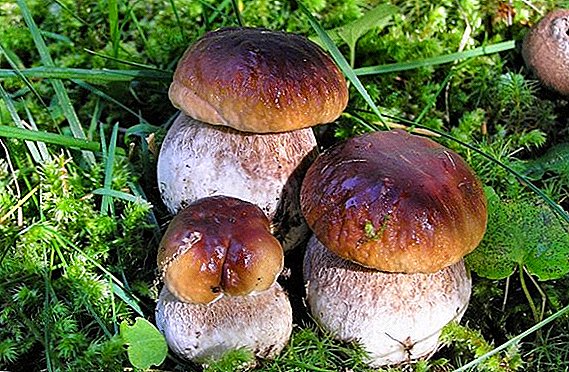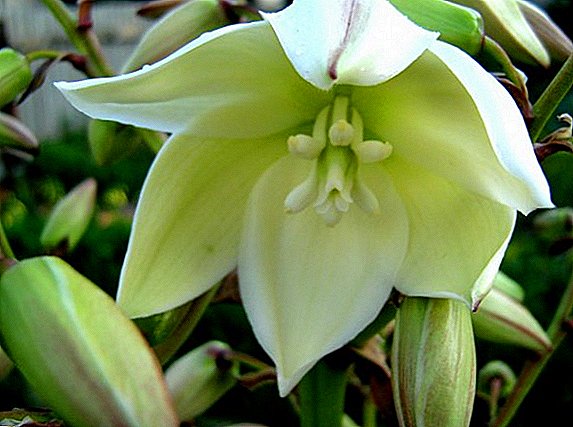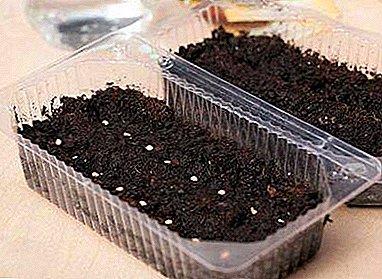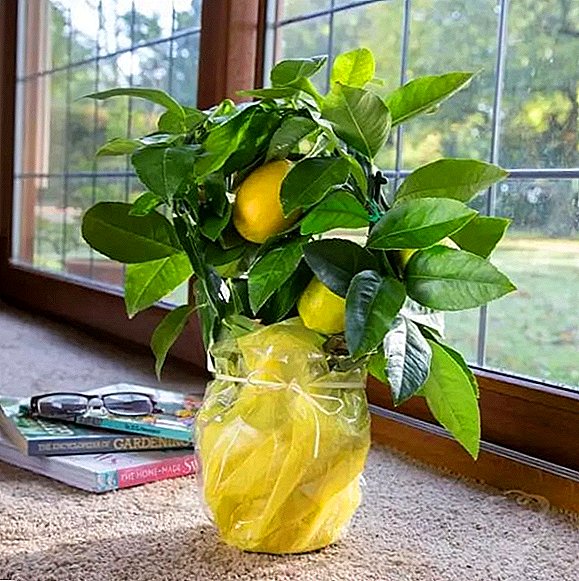 The lemon tree has been widely known to the inhabitants of our planet for the past 8 centuries. In the XII century, the inhabitants of the Indian state domesticated this citrus tree and began to use its fruits not only in cooking, but also in medicine.
The lemon tree has been widely known to the inhabitants of our planet for the past 8 centuries. In the XII century, the inhabitants of the Indian state domesticated this citrus tree and began to use its fruits not only in cooking, but also in medicine.
Today, this beautiful tree can be grown for decorative purposes right in the apartments. In the article we will talk about how to grow and plant a lemon at home, how to care for a tree and treat it for various diseases.
Indoor Lemon: Choice of Variety for Home Growing
This citrus culture with great difficulty endures acclimatization and often dies in conditions unfit for growth and development.
If a lemon tree seedling was brought from southern countries (India, Brazil, etc.), where it grew under the open sky, then, most likely, such a tree will die with time. Therefore, when buying is to give preference to those sellers who offer seedlings, propagated from the local indoor plants.
Important! Get a special lamp for lemon to reduce the risk of disease on the background of lack of regular sunlight.
 Lemon plants reproduce by cutting or grafting. This is a must and it is worth paying attention to when purchasing.
Lemon plants reproduce by cutting or grafting. This is a must and it is worth paying attention to when purchasing.The seller must be asked whether the plant was imported from Armenia, Georgia or Azerbaijan. After all, the seedlings in these countries were separated from the trees growing under the open sky, and they will not survive in your apartment.
You need to buy a lemon plant grafted on the "Trifoliat", since this is the best option for decorative cultivation in our climate zone.
It is necessary to buy lemon saplings only from trusted sellers, and ask them in detail all the data about the seedling. For the southern regions of our country The most suitable lemon varieties will be Lisbon, Genoa, Meyer, Maikop.
Learn more about the beneficial and dangerous properties of lemon.If the cultivation of lemon at home will occur in the northern regions, then you need to look for such varieties: "Pavlovsky", "Kursky", "Lunario", "Ponderoza".
How to create the best conditions for planting lemon tree at home
In order for the citrus plant not to feel discomfort and grow in the most optimal conditions, it must be properly planted, to find the best soil and place in the apartment. 
The choice of space in the room
From the right place in the home will depend on the fate of homemade lemon. If you place this plant on the balcony (many people place it there), then you need to carefully monitor the temperature drops that the lemon tree does not tolerate.
Natural sunlight will fall on the crown of the plant only a few hours a day (in the morning or in the evening, depending on the location of the balcony), while the heat from the rooms will be regular, within +20 ° C.
Heat masses from a heater or batteries will also warm only one part of the citrus plant. The result will be a constant temperature differential, due to which a tree can often shed leaves or even die.
To avoid this, on the balcony you need to maintain a stable temperature throughout the volume.  If you place a room lemon on the windowsill, then again, the sun's rays will illuminate only one part of the crown. In addition, the summer heat can contribute to the shrinkage of the root system.
If you place a room lemon on the windowsill, then again, the sun's rays will illuminate only one part of the crown. In addition, the summer heat can contribute to the shrinkage of the root system.
To prevent this, the citrus tree should be regularly watered and deployed daily. Of course, the most ideal option for placing a tree will be a bay window, where lighting will occur in a more or less normal way.
Did you know? Initially, a lemon was brought to Europe by the army of Alexander the Great. For a long time, the Europeans called it the "Indian apple."
However, in winter, citrus plants require different conditions. From early November to mid-February, the plant is better to “slow down” in growth, to make the so-called artificial rest stage.
Due to the fact that in winter the rays of the sun no longer warm, the tree must be at temperatures of + 5-10 ° C. Moreover, it is important that any sharp temperature drop may adversely affect the plant.
Therefore, if the lemon is contained on the balcony or in the bay window, then try not to open the door there for longer than 5 minutes, otherwise the thermal masses will begin to fill the space of the colder room.
I would also like to note that an ideal place for citrus tree growth will be a room with a glass roof, where a stable temperature of about +20 ° C and high humidity are maintained. 
How to choose a container for planting lemon at home
In order to properly plant a lemon at home, you need to know how to choose the optimal capacity. The lemon tree planting pot can be made from any material: plastic, wood, metal, ceramics, etc.
When buying a container, pay attention to the fact that its upper diameter should be no more than 15 cm, and at the very bottom there should be several small holes for draining excess water.
The height of the pot should be 15-20 cm. It is better not to buy particularly high containers, since the roots of the lemon are small and you only take a lot of space on the balcony.
You will probably be interested to learn more about growing citrus fruits such as calamondin, mandarin and citron at home.
What should be the soil for homemade harvest
At the bottom of the pot you need to make a drainage with a height of 3-5 cm. Drainage is made from sand or wood ash. However, ash combined with sand will be the best drainage. The bottom of the pot should be filled with 3 cm of ash, and then filled with a 2 cm layer of sand.
Soil for homemade lemon should be special, the soil from your garden or garden just will not work. It is best to buy this soil in specialized stores. Just ask the vendors if they have soil for indoor citrus plants.  If you do not have the opportunity to buy soil, you can prepare it yourself. To do this, take the forest land (top layer, no deeper than 10 cm, preferably under old deciduous trees, except for oak and poplar), river sand, humus and wood ash (ashes can be purchased in the store, as well as sand with humus).
If you do not have the opportunity to buy soil, you can prepare it yourself. To do this, take the forest land (top layer, no deeper than 10 cm, preferably under old deciduous trees, except for oak and poplar), river sand, humus and wood ash (ashes can be purchased in the store, as well as sand with humus).
It is important to respect the proportions in the preparation of lemon soil: for two glasses of forest soil you need to add a glass of sand, 3 tablespoons of humus and 1 tablespoon of wood ash.
Stir the mixture with water until a creamy mass is obtained. This mass needs to fill the pot so that the roots of the lemon are completely covered. After 6 months, the tree is preferably transplanted into a wider container (diameter 20-25 cm).
Features planting lemon home
Any ornamental plants do not like the dense composition of the soil. Under natural conditions, in the open air, any tree does not suffer from a high density of soil, since it is loosened by worms that feed on leaves.
At home, to achieve such conditions is extremely difficult, but the holes in the pot and sand in the soil to some extent solve this problem.
Before planting, this should be taken into account, and trying to make the conditions for lemon growth as acceptable as possible, because otherwise the roots of the tree will die due to lack of water and air permeability.
Important! For the normal fruiting of the lemon tree, you need to warm the pot in which it grows.
 Before planting, you need to fill the container for lemon with previously prepared soil (1/3 part). Next - insert a tree and slowly fill the roots with soil (but do not fill the ground to the very edges, leave 10-12 mm of empty space above, where you will add water).
Before planting, you need to fill the container for lemon with previously prepared soil (1/3 part). Next - insert a tree and slowly fill the roots with soil (but do not fill the ground to the very edges, leave 10-12 mm of empty space above, where you will add water).Lemon should be planted in such a way that the root neck is at a depth of 4-6 mm. It is very important to “drown” the root collar in the soil, otherwise with regular and abundant watering it will begin to rot, which will lead to the death of the citrus plant.
How to care for lemon at home
In order for the lemon tree to grow normally and regularly bear fruit at home, it needs to provide special care: properly water, fertilize, trim and replant.
Lemon tree watering frequency
Watering a citrus plant is an important step in the process of caring for a plant. Moisten the soil should be regularly, in order to prevent the formation of surface dry lump in the pot.
Every day, try to check the soil for moisture: if the primer sticks to the arm, it means that it is not necessary to water the tree, but if it crumbles into grains of sand, you need abundant watering.
The water that flows from the taps in high-rise buildings is not suitable for watering a room lemon, as it contains many alkaline metal macronutrients, as well as chlorine ions. Such water can cause leaf chlorosis and other tree diseases.  It is best to take water from a well or a well, defend it during the day, and then water the plant. But if you do not have the opportunity to collect some water from a well or a well, then take hot tap water (it minimizes chlorine content) and infuse it for 24-36 hours.
It is best to take water from a well or a well, defend it during the day, and then water the plant. But if you do not have the opportunity to collect some water from a well or a well, then take hot tap water (it minimizes chlorine content) and infuse it for 24-36 hours.
Water temperature for irrigation should be + 30-35 ° C, especially in the winter season.
A container for watering a lemon tree should be with a narrow neck. When watering, tilt it close to the soil, so that a strong water pressure could not expose the root system of the plant.
The number of the best potted trees includes Benjamin's ficus, boxwood, laurel, Hoveya Belmor, dracaena, sweetie, hibiscus, abutilon.Water need not regret, water the lemon until then, until you see the liquid flowing out of the lower holes. This will mean that all the soil along with the roots is saturated with water.
Excess water can be removed from the pallet 30-40 minutes after watering. It should also be noted that a citrus plant in a natural range grows in a tropical, humid climate, where frequent rainfall is normal.
Therefore, try 1-2 times a day to spray lemon leaves with water. So you can create optimal humidity. 
How to fertilize lemon
Lemon, like other indoor plants, requires special care. Growing this citrus plant at home places the responsibility on the host, and if the plant is not fed in a timely manner, then over time it will no longer bear fruit, and may later die altogether.
In the first month after planting, there is no need to feed the tree, since it takes all the macro and microelements it needs from a limited amount of soil. Over time, that is, in a month, the minerals in the pot run out, and now the lemon tree needs to be fertilized every 7-10 days.
Did you know? In the 17th century, lemon was an elite fruit and cost a lot of money. It was ordered only by rich people. Delivered lemons from Holland, and in salted form.
Fertilize the plant need special solutions that can be found on the shelves of botanical shops. Fertilizers should be applied the next day after watering, when the soil is still wet.
If you fertilize the lemon with liquid fertilizer in a dry soil, there is always the risk of burning the roots. To increase resistance to various diseases, lemon can be treated with potassium permanganate solution (pink).
In the spring, when a lemon comes out of dormancy, it must be fed with urea: for 1 liter of water, 1 teaspoonful of urea, and water until the liquid begins to flow into the pan. Iron oxide will be an excellent fertilizer, which must be mixed with the top layer of soil (but do not confuse it with oxide, because lemon does not like rust in the plant).
When a tree grows and begins to bloom, it must be fed with fertilizers rich in trace elements phosphorus. This may be a decoction of fish, an aqueous solution of fish meal, etc.
In autumn, when the lemon is prepared for the rest period, it can be watered with natural black tea 2-3 times at weekly intervals. In the period from November to February, the plant does not need feeding, as it is at rest.
How and when to prune the plant
There is a lot of information on how to rejuvenate and trim a room lemon. Some recommend cutting the plant in the fall, the second - in the winter, and others - in the spring.
Moreover, each of the “specialists” has a lot of positive arguments in the direction of his own method of pruning.
Autumn pruning, which takes place in November, allegedly increases the fruiting of the tree, winter pruning (in February) causes minimal damage to the tree, and spring - stimulates the growth of young shoots, respectively, increases fructification and strengthens the tree.  Therefore, from a professional point of view, the most optimal period for the rejuvenation and pruning of citrus trees will be spring, when the process of budding and flowering begins.
Therefore, from a professional point of view, the most optimal period for the rejuvenation and pruning of citrus trees will be spring, when the process of budding and flowering begins.
Cut the lemon plant is needed in order to form a crown, give growth to young shoots and provide the maximum possible coverage of the entire plant.
Therefore, in the process of pruning, it is necessary to take into account the fact that a very dense plant will constantly need sunlight, in addition, a thick lemon will produce fewer fruits.
The first pruning of the citrus tree should be done only when it reaches a height of at least 20 cm. First, a zero-order shoot (main trunk of the tree) is cut at a height of 20-30 cm (4 developed buds are left).
Over time, there will appear lateral skeletal branches, on which beautiful lemon fruits will ripen. The shoots of the first and second order are cut to a height of 20-25 cm.  Only those that interfere with the growth of young shoots are completely removed. Shoots of the third order are cut at a height of 15 cm, the fourth - 10 cm. Shoots of subsequent orders are not cut.
Only those that interfere with the growth of young shoots are completely removed. Shoots of the third order are cut at a height of 15 cm, the fourth - 10 cm. Shoots of subsequent orders are not cut.
Lemon tree transplant basics at home
There are several reasons for transplanting lemon tree, and you need to be able to identify them in a timely manner:
- The lemon has grown a lot and there is little room in the old pot. Liberally water the plant, turn the pot to a horizontal position and try to remove the tree along with the earthy ball. If roots stick out from all sides, an immediate transfer to a wider and deeper container is necessary.
- Lemon tree struck root rot. If the roots of citrus began to produce an unpleasant rotten smell, they should be washed in potassium permanganate, and the plant should be urgently planted in a new pot with new soil.
- Crashed pot plant. In this case, you need to purchase a new container, and for a while wrap the lemon tree root system with a wet rag (in this form, the tree cannot be kept longer than a day). When transplanting into the soil you need to add the drug "Kornevin".
- The plant has ceased to actively grow and bear fruit. This is a sign that it lacks trace elements in the soil and room for normal growth and development of the roots, so a transplant is required, and the sooner the better.
Important! Treatment of lemon trees with insecticides should be carried out only in non-residential premises.
If you find a reason for transplanting in your tree, then you need to act immediately. The transplant rules are very similar to the planting rules, so you need to pick up the pot and soil for filling as described in several points above.
But during transplantation, it is necessary to focus on the state of the root system of the adult lemon tree. If some processes are affected by rot and an unpleasant smell emanates from them, then carefully remove all rotten roots.
Then pour some soil into a new pot and add "Kornevina" there. Insert a tree with a lump on the root system and sprinkle with soil to the desired level.
Then, throughout the month, the transplanted lemon should be more carefully looked after: regularly water and fertilize, monitor the air temperature and humidity, etc.
Since in the first month the root system of the lemon will actively dissolve its roots throughout the entire container, try to feed the plant with phosphorus fertilizers at least once a week. 
Difficulties in growing indoor lemon
Growing a gorgeous lemon tree at home is not so easy, difficulties always await in the most unexpected places.
In order for the citrus plant not to hurt and regularly bear fruit, we need timely watering, fertilizing, maintaining temperature and humidity, regular lighting, timely transplanting, etc.
All the listed subtleties in the care of a tree should be performed regularly and in a timely manner, and this is difficult even for housewives who are constantly at home, because you can always forget and miss some point in the care. For example, improper lighting and failure in temperature conditions can cause early leaf fall, and excessive watering can cause root rot.
Без подкормок дерево не сможет нормально расти и плодоносить, а пониженная влажность приведет к тому, что листочки начнут желтеть. Все эти трудности всегда заставляют задуматься перед покупкой лимонного дерева.  But many citrus enthusiasts claim that over the years, all difficulties disappear, and people get used to their plants. Caring for them no longer seems so difficult, moreover, a new experience appears, and citrus fruits begin to grow and bear fruit more actively.
But many citrus enthusiasts claim that over the years, all difficulties disappear, and people get used to their plants. Caring for them no longer seems so difficult, moreover, a new experience appears, and citrus fruits begin to grow and bear fruit more actively.
Plant Diseases and Pests
The most common homemade lemon disease is yellowing of the leaves. The causes of this phenomenon can be many different factors, depending on which and need to take measures for treatment. The main causes of yellowed leaves:
- low air humidity;
- irregular and improper feeding;
- increased air temperature during the rest period (from November to February the lemon tree should be maintained at temperatures of + 6-10 ° C);
- defeat spider mite.
The first three reasons are eliminated by mechanical methods, and to combat a spider mite, you need to use such chemicals as Kleschevit, Akarin, Fitoverm, etc.
Sometimes the leaves of the lemon tree may fall out of time. Such a phenomenon may be associated again with the presence of a spider mite. But besides it, unstable temperature conditions, poor lighting, as well as low humidity of the soil and air can contribute to leaf fall.
Moreover, improper care of citrus plants provokes drying of young green leaves. 
Did you know? One ripe lemon contains more sugar than one ripe strawberry.
The main pests of a lemon tree, besides spider mites, are aphids, scale insects, whiteflies and mealybugs.
To combat these parasites, as well as prevention, you can use the advice of the people: make a tincture of garlic (150 g of garlic per 1 liter of water), leave for 6-7 days, then 6-7 g of tincture dilute in 1 liter of water and process the plant.
If the pests massively hit the lemon, then you need to use purchased insecticides.
As a result of all that has been said in this article, I would like to note that it is not so easy to grow a beautiful and prolific lemon at home, but if you use all our advice, then you will definitely succeed.
After all, every amateur citrus fruit once started with the basics, and you should not be afraid. Buy a sapling, plant it, provide him with proper care, and he will delight you with the fruits of more than a dozen years. 












